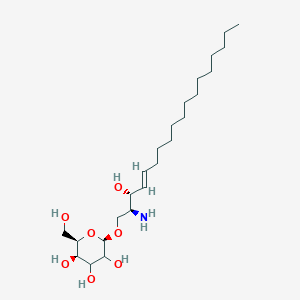| MeSH term | MeSH ID | Detail |
|---|---|---|
| Hemolysis | D006461 | 131 associated lipids |
| Uterine Cervical Neoplasms | D002583 | 10 associated lipids |
| Leukodystrophy, Metachromatic | D007966 | 4 associated lipids |
| Leukodystrophy, Globoid Cell | D007965 | 6 associated lipids |
| Nerve Degeneration | D009410 | 53 associated lipids |
| Encephalomyelitis, Autoimmune, Experimental | D004681 | 26 associated lipids |
| Gaucher Disease | D005776 | 13 associated lipids |
| Optic Atrophy | D009896 | 2 associated lipids |
PSYCHOSINE
PSYCHOSINE is a lipid of Sphingolipids (SP) class. Psychosine is associated with abnormalities such as Globoid cell leukodystrophy, Demyelinating Diseases, Multiple Sclerosis, nervous system disorder and Lysosomal Storage Diseases. The involved functions are known as Ionization, Pathogenesis, Demyelination, 5-(carboxyamino)imidazole ribonucleotide mutase activity and Increased Sensitivy. Psychosine often locates in Body tissue, CNS - Brain (MMHCC), Autosome, Peripheral Nervous System and Nerve Tissue. The associated genes with PSYCHOSINE are GALC gene, NTRK1 gene, JUN gene, ALPP gene and Polylysine. The related lipids are Fatty Acids, fatty aldehyde, lysophosphatidic acid, Stearic acid and stearoyl chloride. The related experimental models are Mouse Model and Streptozotocin Diabetes.
Cross Reference
Introduction
To understand associated biological information of PSYCHOSINE, we collected biological information of abnormalities, associated pathways, cellular/molecular locations, biological functions, related genes/proteins, lipids and common seen animal/experimental models with organized paragraphs from literatures.
What diseases are associated with PSYCHOSINE?
PSYCHOSINE is suspected in Globoid cell leukodystrophy, Enzyme Deficiency, Demyelinating Diseases, Multiple Sclerosis, nervous system disorder, Lysosomal Storage Diseases and other diseases in descending order of the highest number of associated sentences.
Related references are mostly published in these journals:
| Disease | Cross reference | Weighted score | Related literature |
|---|
Possible diseases from mapped MeSH terms on references
We collected disease MeSH terms mapped to the references associated with PSYCHOSINE
PubChem Associated disorders and diseases
What pathways are associated with PSYCHOSINE
Lipid pathways are not clear in current pathway databases. We organized associated pathways with PSYCHOSINE through full-text articles, including metabolic pathways or pathways of biological mechanisms.
Related references are published most in these journals:
| Pathway name | Related literatures |
|---|
PubChem Biomolecular Interactions and Pathways
Link to PubChem Biomolecular Interactions and PathwaysWhat cellular locations are associated with PSYCHOSINE?
Visualization in cellular structure
Associated locations are in red color. Not associated locations are in black.
Related references are published most in these journals:
| Location | Cross reference | Weighted score | Related literatures |
|---|
What functions are associated with PSYCHOSINE?
Related references are published most in these journals:
| Function | Cross reference | Weighted score | Related literatures |
|---|
What lipids are associated with PSYCHOSINE?
Related references are published most in these journals:
| Lipid concept | Cross reference | Weighted score | Related literatures |
|---|
What genes are associated with PSYCHOSINE?
Related references are published most in these journals:
| Gene | Cross reference | Weighted score | Related literatures |
|---|
What common seen animal models are associated with PSYCHOSINE?
Mouse Model
Mouse Model are used in the study 'Psychosine accumulates in membrane microdomains in the brain of krabbe patients, disrupting the raft architecture.' (White AB et al., 2009).
Streptozotocin Diabetes
Streptozotocin Diabetes are used in the study 'Direct quantitation of psychosine from alkaline-treated lipid extracts with a semi-synthetic internal standard.' (Jiang X et al., 2009).
Related references are published most in these journals:
| Model | Cross reference | Weighted score | Related literatures |
|---|
NCBI Entrez Crosslinks
All references with PSYCHOSINE
Download all related citations| Authors | Title | Published | Journal | PubMed Link |
|---|---|---|---|---|
| Yamamoto H et al. | Sphingosylphosphorylcholine and lysosulfatide have inverse regulatory functions in monocytic cell differentiation into macrophages. | 2011 | Arch. Biochem. Biophys. | pmid:21081108 |
| Reddy AS et al. | Bone marrow transplantation augments the effect of brain- and spinal cord-directed adeno-associated virus 2/5 gene therapy by altering inflammation in the murine model of globoid-cell leukodystrophy. | 2011 | J. Neurosci. | pmid:21734286 |
| Contreras MA et al. | Factors that affect postnatal bone growth retardation in the twitcher murine model of Krabbe disease. | 2010 Jul-Aug | Biochim. Biophys. Acta | pmid:20441793 |
| Lankalapalli RS et al. | Synthesis and properties of a photoactivatable analogue of psychosine (beta-Galactosylsphingosine). | 2010 | ChemMedChem | pmid:20209561 |
| Banerjee Y et al. | Triglyceride-mediated pathways and coronary heart disease. | 2010 | Lancet | pmid:20851256 |
| Auray-Blais C et al. | How well does urinary lyso-Gb3 function as a biomarker in Fabry disease? | 2010 | Clin. Chim. Acta | pmid:20716442 |
| Sun Y et al. | Neuronopathic Gaucher disease in the mouse: viable combined selective saposin C deficiency and mutant glucocerebrosidase (V394L) mice with glucosylsphingosine and glucosylceramide accumulation and progressive neurological deficits. | 2010 | Hum. Mol. Genet. | pmid:20047948 |
| Pannuzzo G et al. | A galactose-free diet enriched in soy isoflavones and antioxidants results in delayed onset of symptoms of Krabbe disease in twitcher mice. | 2010 | Mol. Genet. Metab. | pmid:20418135 |
| White AB et al. | Psychosine accumulates in membrane microdomains in the brain of krabbe patients, disrupting the raft architecture. | 2009 | J. Neurosci. | pmid:19439584 |
| Jiang X et al. | Direct quantitation of psychosine from alkaline-treated lipid extracts with a semi-synthetic internal standard. | 2009 | J. Lipid Res. | pmid:18753677 |
